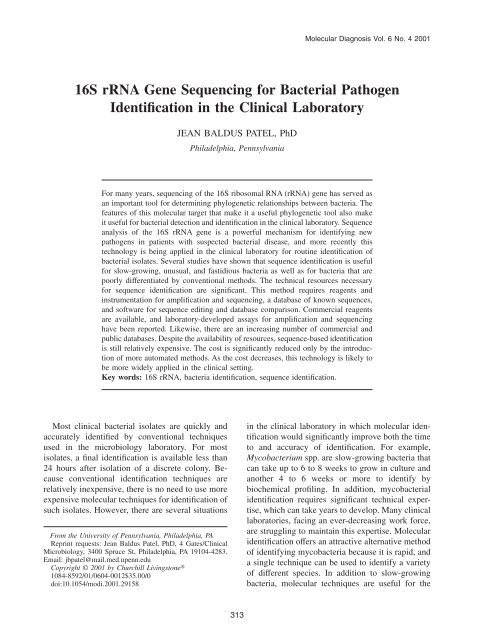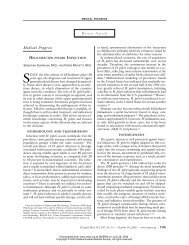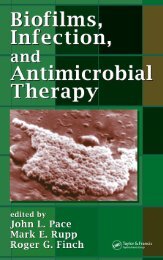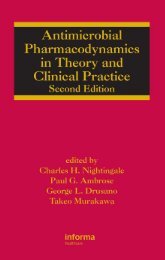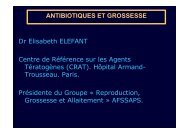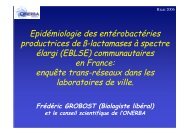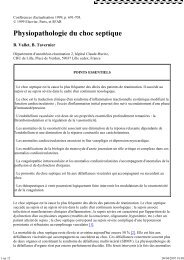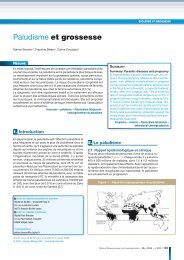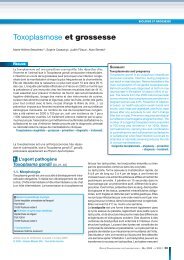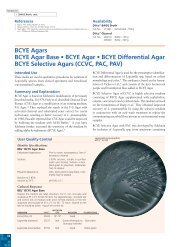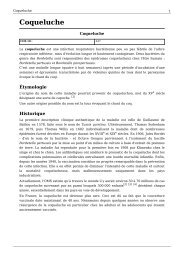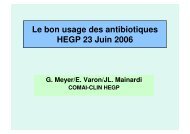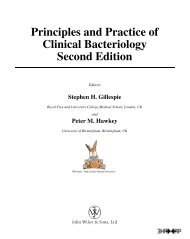16S rRNA Gene Sequencing for Bacterial Pathogen Identification in ...
16S rRNA Gene Sequencing for Bacterial Pathogen Identification in ...
16S rRNA Gene Sequencing for Bacterial Pathogen Identification in ...
Create successful ePaper yourself
Turn your PDF publications into a flip-book with our unique Google optimized e-Paper software.
318 Molecular Diagnosis Vol. 6 No. 4 December 2001ported as Mycobacterium szulgai. However, bothisolates had the same 5' 500-bp sequence, and thissequence is unique from any other sequences <strong>in</strong> Gen-Bank [21]. These two isolates are likely related toeach other at the species-level and probably representa novel species, yet identification by nonsequencemethods provides no <strong>in</strong><strong>for</strong>mation that theseisolates are closely related to each other. Increaseduse of sequence-based identification has led to a significant<strong>in</strong>crease <strong>in</strong> newly described, medically importantMycobacterium spp. (Table 2).<strong>Sequenc<strong>in</strong>g</strong> was also evaluated as an identificationmethod <strong>for</strong> groups of bacteria that either arepoorly differentiated us<strong>in</strong>g conventional methods orrequire more than 48 hours to identify. Tang et al.[17] compared three rapid identification methodswith conventional phenotypic identification <strong>for</strong> unusualaerobic Gram-negative bacteria. The threerapid methods were based on <strong>16S</strong> <strong>rRNA</strong> gene sequenc<strong>in</strong>g(MicroSeq), cellular fatty acid profiles, andcarbon source use. MicroSeq identification matchedboth the genus and species reference identity moreoften than did the identifications produced by eitherof the other methods. Additionally, their datashowed that a 5' 500-bp MicroSeq identity was comparableto a full gene identity. The full gene and500-bp <strong>16S</strong> <strong>rRNA</strong> gene identities always agreed atthe genus level, and 93.1% of the 500-bp speciesassignments were the same as the species assignmentsby the full gene method. In another study byTang et al. [32], the MicroSeq 5' 500-bp identificationproved a useful tool <strong>for</strong> the identification ofCorynebacterium and Corynebacterium-relatedisolates. Sequence identification provided the sameTable 2. Medically Important Mycobacterium spp.Recently Recognized by <strong>16S</strong> <strong>rRNA</strong><strong>Gene</strong> <strong>Sequenc<strong>in</strong>g</strong>New SpeciesReferenceM. genavense 39M. branderi 40M. <strong>in</strong>terjectum 41M. conspicuum 42M. lentiflavum 43M. novocastrense 44M. triplex 45M. bohemicum 13M. heidelbergense 46M. tusciae 47M. wol<strong>in</strong>skyi 48M. heckeshornense 49genus identity as conventional and supplementedphenotypic methods <strong>for</strong> all isolates tested. Thespecies-level identity was the same <strong>for</strong> 66.7% of allisolates. Sequence identification was most reliable(100% concordance) <strong>for</strong> the two most cl<strong>in</strong>ically significantspecies, Corynebacterium diptheriae andCorynebacterium jeikeium. <strong>16S</strong> <strong>rRNA</strong> gene sequenc<strong>in</strong>gis a particularly important method <strong>for</strong> identificationof fastidious bacteria both from culture andfrom cl<strong>in</strong>ical specimens. Our laboratory was able toidentify a blood culture isolate that failed to grow onconventional media as Leptotrichia sp. only after analiquot of the positive blood culture bottle was submitted<strong>for</strong> sequence analysis [33]. <strong>Sequenc<strong>in</strong>g</strong> also<strong>in</strong>dicated that this isolate is probably a novel speciesof Leptotrichia. The literature conta<strong>in</strong>s several similarreports. For example, the uncommon isolateAnaerobiospirillum succ<strong>in</strong>iciproducens was identifiedas a cause of bacteremia <strong>in</strong> three patients bysequence identification [34]. In another report, anisolate from jo<strong>in</strong>t fluid of a patient with septic arthritiswas identified as a novel species of Helicobacter[35]. Sequence identification will undoubtedly beapplied to the identification of other groups of bacterialisolates. Our laboratory is currently evaluat<strong>in</strong>gsequenc<strong>in</strong>g as a means of identify<strong>in</strong>g isolates ofaerobic and anaerobic act<strong>in</strong>omycetes.More often, cl<strong>in</strong>ical laboratories are us<strong>in</strong>g sequenceidentification to detect and identify pathogensdirectly from cl<strong>in</strong>ical specimens that shouldotherwise be sterile. Neisseria men<strong>in</strong>gitidis wasidentified <strong>in</strong> bra<strong>in</strong> pus from a patient with culturenegativemen<strong>in</strong>gitis [36]. The isolate presumablyfailed to grow because of prior antibiotic use. Anovel Helicobacter species was identified directlyfrom dra<strong>in</strong>age of an abdom<strong>in</strong>al abscess <strong>in</strong> a patientwith X-l<strong>in</strong>ked hypogammaglobul<strong>in</strong>emia [37]. Ourlaboratory used <strong>16S</strong> <strong>rRNA</strong> gene sequenc<strong>in</strong>g todetect and identify Mycoplasma orale <strong>in</strong> the tissueof a patient with hypogammaglobul<strong>in</strong>aemia whowas suffer<strong>in</strong>g from a persistently culture-negative<strong>in</strong>flammatory arthritis (M. Paessler, M. Shuster, J.B.Patel, I. Nachamk<strong>in</strong>, unpublished data). Althoughsequence-based identification directly from a cl<strong>in</strong>icalspecimen is a potentially powerful technique,this technology lacks some of the advantages thatculture provides. For example, sequence-basedidentification does not easily allow <strong>for</strong> the detectionof multiple pathogens, and there is no way tomeasure the relative abundance of different organisms.Likewise, without culture there is no isolate
<strong>16S</strong> Ribosomal RNA <strong>Gene</strong> <strong>Sequenc<strong>in</strong>g</strong> O Patel 319<strong>for</strong> further characterization such as susceptibilitytest<strong>in</strong>g. For these reasons, sequence-based identificationdirectly from a cl<strong>in</strong>ical specimen is primarilyused only when culture has failed or is not possible.Is Sequence-based <strong>Identification</strong>Cost-effective?<strong>Sequenc<strong>in</strong>g</strong> is a relatively expensive method ofidentification. One laboratory estimated their cost atapproximately $84.25 per test, and another laboratorycalculated a cost of $40.00 to $85.00 per test[32,38]. We have estimated our cost to per<strong>for</strong>m as<strong>in</strong>gle identification, which <strong>in</strong>cludes a negativeamplification control, to be $144.00 (J.B. Patel,unpublished data). This number <strong>in</strong>cludes the cost ofextraction, disposables, reagents, database use, andlabor. Most of the cost is labor, so the total costdrops to $87.00 per identification if two isolates aresequenced at the same time. These figures do not<strong>in</strong>clude the cost of purchas<strong>in</strong>g <strong>in</strong>strumentation.One justification <strong>for</strong> the expense of sequencebasedidentification is that the improved accuracyand speed of this method will have a positive impacton cl<strong>in</strong>ical care. However, there are no studies evaluat<strong>in</strong>gthe impact of sequence-based identification onthe quality of patient care or the cost of treat<strong>in</strong>g apatient. Despite this lack of data, it may not be necessaryto look beyond a laboratory’s own budget tojustify the expense of sequenc<strong>in</strong>g. For example, alaboratory may not have the capability of per<strong>for</strong>m<strong>in</strong>gmycobacterial identification <strong>in</strong>-house, but thecost of send<strong>in</strong>g the specimen to a reference laboratoryfar exceeds the cost of a sequence-based identification.Such a laboratory may consider sequenc<strong>in</strong>g,especially <strong>in</strong> a situation <strong>in</strong> which <strong>in</strong>struments<strong>for</strong> amplification and sequence analysis are alreadyavailable or can be shared.The <strong>in</strong>troduction of more automated methodsundoubtedly will have the biggest impact on decreas<strong>in</strong>gthe cost of sequence identification and willresult <strong>in</strong> <strong>in</strong>creased use of this technology <strong>in</strong> hospitaland reference laboratories.Conclusions<strong>Sequenc<strong>in</strong>g</strong> of the <strong>16S</strong> <strong>rRNA</strong> gene is a powerfulidentification method <strong>in</strong> the cl<strong>in</strong>ical laboratory. Thistechnique is applicable <strong>for</strong> rout<strong>in</strong>e identification ofseveral groups of bacteria as well as <strong>for</strong> identificationof novel isolates. As the technical resources <strong>for</strong>sequence identification become more abundant andless expensive, more cl<strong>in</strong>ical microbiologists willconsider us<strong>in</strong>g this method <strong>in</strong> their laboratories’work flow.Received June 12, 2001.Received <strong>in</strong> revised <strong>for</strong>m August 8, 2001.Accepted August 10, 2001.References1. Lebrun L, Esp<strong>in</strong>asse F, Poveda JD, V<strong>in</strong>cent-Levy-Frebault V: Evaluation of nonradioactive DNAprobes <strong>for</strong> identification of mycobacteria. J Cl<strong>in</strong>Microbiol 1992;30:2476–24782. Bourbeau PP, Heiter BJ, Figdore M: Use of Gen-Probe AccuProbe Group B streptococcus test todetect group B streptococci <strong>in</strong> broth cultures ofvag<strong>in</strong>al-anorectal specimens from pregnant women:Comparison with traditional culture method. J Cl<strong>in</strong>Microbiol 1997;35:144–1473. Denys GA, Carey RB: <strong>Identification</strong> of Streptococcuspneumoniae with a DNA probe. J Cl<strong>in</strong> Microbiol1992;30:2725–27274. Young H, Moyes A: Comparative evaluation ofAccuProbe culture identification test <strong>for</strong> Neisseriagonorrhoeae and other rapid methods. J Cl<strong>in</strong> Microbiol1993;31:1996–19995. Padhye AA, Smith G, McLaughl<strong>in</strong> D, Standard PG,Kaufman L: Comparative evaluation of a chemilum<strong>in</strong>escentDNA probe and an exoantigen test <strong>for</strong>rapid identification of Histoplasma capsulatum. JCl<strong>in</strong> Microbiol 1992;30:3108–31116. Padhye AA, Smith G, Standard PG, McLaughl<strong>in</strong> D,Kaufman L: Comparative evaluation of chemilum<strong>in</strong>escentDNA probe assays and exoantigen tests <strong>for</strong>rapid identification of Blastomyces dermatitidis andCoccidioides immitis. J Cl<strong>in</strong> Microbiol 1994;32:867–8707. West<strong>in</strong> L, Miller C, Vollmer D, Canter D, RadtkeyR, Nerenberg M, O’Connell JP: Antimicrobial resistanceand bacterial identification utiliz<strong>in</strong>g a microelectronicchip array. J Cl<strong>in</strong> Microbiol 2001;39:1097–11048. Anthony RM, Brown TJ, French GL: Rapid diagnosisof bacteremia by universal amplification of23S ribosomal DNA followed by hybridization toan oligonucleotide array. J Cl<strong>in</strong> Microbiol 2000;38:781–788
320 Molecular Diagnosis Vol. 6 No. 4 December 20019. Troesch A, Nguyen H, Miyada CG, Desvarenne S,G<strong>in</strong>geras TR, Kaplan PM, Cros P, Mabilat C:Mycobacterium species identification and rifamp<strong>in</strong>resistance test<strong>in</strong>g with high-density DNA probearrays. J Cl<strong>in</strong> Microbiol 1999;37:49–5510. Relman DA, Loutit JS, Schmidt TM, Falkow S,Tompk<strong>in</strong>s LS: The agent of bacillary angiomatosis.An approach to the identification of unculturedpathogens. N Engl J Med 1990;323:1573–158011. Relman DA, Schmidt TM, MacDermott RP, FalkowS: <strong>Identification</strong> of the uncultured bacillus of Whipple’sdisease. N Engl J Med 1992;327:293–30112. Woese CR: <strong>Bacterial</strong> evolution. Microbiol Rev1987;51:221–27113. Reischl U, Emler S, Horak Z, Kaustova J, KroppenstedtRM, Lehn N, Naumann L: Mycobacteriumbohemicum sp. nov., a new slow-grow<strong>in</strong>g scotochromogenicmycobacterium. Int J Syst Bacteriol1998;48 Pt 4:1349–135514. Stackebrant E, Goebel BM: Taxonomic note: Aplace <strong>for</strong> DNA-DNA reassociation and <strong>16S</strong> <strong>rRNA</strong>sequence analysis <strong>in</strong> the present species def<strong>in</strong>ition<strong>in</strong> bacteriology. Int J Syst Bacteriol 1994;44:846–84915. Kusunoki S, Ezaki T: Proposal of Mycobacteriumperegr<strong>in</strong>um sp. nov., nom. rev., and elevation ofMycobacterium chelonae subsp. abscessus (Kubicaet al.) to species status: Mycobacterium abscessuscomb. nov. Int J Syst Bacteriol 1992;42:240–24516. Spr<strong>in</strong>ger B, Bottger EC, Kirschner P, Wallace RJ Jr.:Phylogeny of the Mycobacterium chelonae-like organismbased on partial sequenc<strong>in</strong>g of the <strong>16S</strong><strong>rRNA</strong> gene and proposal of Mycobacterium mucogenicumsp. nov. Int J Syst Bacteriol 1995;45:262–26717. Tang YW, Ellis NM, Hopk<strong>in</strong>s MK, Smith DH,Dodge DE, Pers<strong>in</strong>g DH: Comparison of phenotypicand genotypic techniques <strong>for</strong> identification of unusualaerobic pathogenic gram-negative bacilli. JCl<strong>in</strong> Microbiol 1998;36:3674–367918. Rogall T, Flohr T, Bottger EC: Differentiation ofMycobacterium species by direct sequenc<strong>in</strong>g ofamplified DNA. J Gen Microbiol 1990;136:1915–192019. Woese CR, Gutell R, Gupta R, Noller HF: Detailedanalysis of the higher-order structure of <strong>16S</strong>-likeribosomal ribonucleic acids. Microbiol Rev 1983;47:621–66920. MicroSeq <strong>16S</strong> <strong>rRNA</strong> gene kit protocol. AppliedBiosystems, Forest City, CA, 2000 (www.appliedbiosystems.com)21. Patel JB, Leonard DG, Pan X, Musser JM, BermanRE, Nachamk<strong>in</strong> I: Sequence-based identification ofMycobacterium species us<strong>in</strong>g the MicroSeq 500<strong>16S</strong> rDNA bacterial identification system. J Cl<strong>in</strong>Microbiol 2000;38:246–25122. Harmsen D, Rothganger J, S<strong>in</strong>ger C, Albert J, FroschM: Intuitive hypertext-based molecular identificationof micro-organisms. Lancet 1999;353:29123. Lieft<strong>in</strong>g LW, Andersen MT, Beever RE, GardnerRC, Forster RL: Sequence heterogeneity <strong>in</strong> the two<strong>16S</strong> <strong>rRNA</strong> genes of Phormium yellow leaf phytoplasma.Appl Environ Microbiol 1996;62:3133–313924. Mylvaganam S, Dennis PP: Sequence heterogeneitybetween the two genes encod<strong>in</strong>g <strong>16S</strong> <strong>rRNA</strong> fromthe halophilic archaebacterium Haloarcula marismortui.<strong>Gene</strong>tics 1992;130:399–41025. Nubel U, Engelen B, Felske A, et al.: Sequenceheterogeneities of genes encod<strong>in</strong>g <strong>16S</strong> <strong>rRNA</strong>s <strong>in</strong>Paenibacillus polymyxa detected by temperaturegradient gel electrophoresis. J Bacteriol 1996;178:5636–564326. Wang Y, Zhang Z, Ramanan N: The act<strong>in</strong>omyceteThermobispora bispora conta<strong>in</strong>s two dist<strong>in</strong>ct typesof transcriptionally active <strong>16S</strong> <strong>rRNA</strong> genes. J Bacteriol1997;179:3270–327627. Ueda K, Seki T, Kudo T, Yoshida T, Kataoka M:Two dist<strong>in</strong>ct mechanisms cause heterogeneity of<strong>16S</strong> <strong>rRNA</strong>. J Bacteriol 1999;181:78–8228. N<strong>in</strong>et B, Monod M, Emler S, et al.: Two different<strong>16S</strong> <strong>rRNA</strong> genes <strong>in</strong> a mycobacterial stra<strong>in</strong>. J Cl<strong>in</strong>Microbiol 1996;34:2531–253629. Reischl U, Feldmann K, Naumann L, et al.: <strong>16S</strong><strong>rRNA</strong> sequence diversity <strong>in</strong> Mycobacterium celatumstra<strong>in</strong>s caused by presence of two differentcopies of <strong>16S</strong> <strong>rRNA</strong> gene. J Cl<strong>in</strong> Microbiol 1998;36:1761–176430. Kirschner P, Spr<strong>in</strong>ger B, Vogel U, et al.: Genotypicidentification of mycobacteria by nucleic acid sequencedeterm<strong>in</strong>ation: Report of a 2-year experience<strong>in</strong> a cl<strong>in</strong>ical laboratory. J Cl<strong>in</strong> Microbiol1993;31:2882–288931. Spr<strong>in</strong>ger B, Stockman L, Teschner K, Roberts GD,Bottger EC: Two-laboratory collaborative study onidentification of mycobacteria: Molecular versusphenotypic methods. J Cl<strong>in</strong> Microbiol 1996;34:296–30332. Tang YW, Von Graevenitz A, Wadd<strong>in</strong>gton MG, etal.: <strong>Identification</strong> of coryne<strong>for</strong>m bacterial isolatesby ribosomal DNA sequence analysis. J Cl<strong>in</strong> Microbiol2000;38:1676–167833. Patel JB, Clarridge J, Schuster MS, Wadd<strong>in</strong>gton M,Osborne J, Nachamk<strong>in</strong> I: Bacteremia caused by anovel isolate resembl<strong>in</strong>g Leptotrichia species <strong>in</strong> aneutropenic patient. J Cl<strong>in</strong> Microbiol 1999;37:2064–206734. Tee W, Korman TM, Waters MJ, et al.: Three casesof Anaerobiospirillum succ<strong>in</strong>iciproducens bacter-
<strong>16S</strong> Ribosomal RNA <strong>Gene</strong> <strong>Sequenc<strong>in</strong>g</strong> O Patel 321emia confirmed by <strong>16S</strong> <strong>rRNA</strong> gene sequenc<strong>in</strong>g. JCl<strong>in</strong> Microbiol 1998;36:1209–121335. Husmann M, Gries C, Jehnichen P, et al.: Helicobactersp. stra<strong>in</strong> Ma<strong>in</strong>z isolated from an AIDSpatient with septic arthritis: Case report and nonradioactiveanalysis of <strong>16S</strong> <strong>rRNA</strong> sequence. J Cl<strong>in</strong>Microbiol 1994;32:3037–303936. Logan JM, Orange GV, Maggs AF: <strong>Identification</strong> ofthe cause of a bra<strong>in</strong> abscess by direct <strong>16S</strong> ribosomalDNA sequenc<strong>in</strong>g. J Infect 1999;38:45–4737. Han S, Sch<strong>in</strong>del C, Genitsariotis R, Marker-Hermann E, Bhakdi S, Maeurer MJ: <strong>Identification</strong>of a unique Helicobacter species by <strong>16S</strong> <strong>rRNA</strong> geneanalysis <strong>in</strong> an abdom<strong>in</strong>al abscess from a patientwith X-l<strong>in</strong>ked hypogammaglobul<strong>in</strong>emia. J Cl<strong>in</strong> Microbiol2000;38:2740–274238. Clarridge JE, Zhang Q, Heward S: <strong>16S</strong> rDNAsequence analysis as a real-time addition to thecl<strong>in</strong>ical microbiology laboratory. <strong>Gene</strong>ral Meet<strong>in</strong>gof the American Society <strong>for</strong> Microbiology, Orlando,FL, May 20-24, 2001 (abstr)39. Haas WH, Kirschner P, Zies<strong>in</strong>g S, Bremer HJ,Bottger EC: Cervical lymphadenitis <strong>in</strong> a childcaused by a previously unknown mycobacterium. JInfect Dis 1993;167:237–24040. Koukila-Kahkola P, Spr<strong>in</strong>ger B, Bottger EC, Paul<strong>in</strong>L, Jantzen E, Katila ML: Mycobacterium branderisp. nov., a new potential human pathogen. Int J SystBacteriol 1995;45:549–55341. Spr<strong>in</strong>ger B, Kirschner P, Rost-Meyer G, SchroderKH, Kroppenstedt RM, Bottger EC: Mycobacterium<strong>in</strong>terjectum, a new species isolated from apatient with chronic lymphadenitis. J Cl<strong>in</strong> Microbiol1993;31:3083–3089 (erratum J Cl<strong>in</strong> Microbiol1994;32:1417)42. Spr<strong>in</strong>ger B, Tortoli E, Richter I, et al.: Mycobacteriumconspicuum sp. nov., a new species isolatedfrom patients with dissem<strong>in</strong>ated <strong>in</strong>fections. J Cl<strong>in</strong>Microbiol 1995;33:2805–281143. Spr<strong>in</strong>ger B, Wu WK, Bodmer T, et al.: Isolation andcharacterization of a unique group of slowly grow<strong>in</strong>gmycobacteria: Description of Mycobacteriumlentiflavum sp. nov. J Cl<strong>in</strong> Microbiol 1996;34:1100–110744. Shojaei H, Goodfellow M, Magee JG, Freeman R,Gould FK, Brignall CG: Mycobacterium novocastrensesp. nov., a rapidly grow<strong>in</strong>g photochromogenicmycobacterium. Int J Syst Bacteriol 1997;47:1205–120745. Floyd MM, Guthertz LS, Silcox VA, et al.: Characterizationof an SAV organism and proposal ofMycobacterium triplex sp. nov. J Cl<strong>in</strong> Microbiol1996;34:2963–296746. Haas WH, Butler WR, Kirschner P, et al.: A newagent of mycobacterial lymphadenitis <strong>in</strong> children:Mycobacterium heidelbergense sp. nov. J Cl<strong>in</strong> Microbiol1997;35:3203–320947. Tortoli E, Kroppenstedt RM, Bartoloni A, et al.:Mycobacterium tusciae sp. nov. Int J Syst Bacteriol1999;49 Pt 4:1839–184448. Brown BA, Spr<strong>in</strong>ger B, Ste<strong>in</strong>grube VA, et al.:Mycobacterium wol<strong>in</strong>skyi sp. nov. and Mycobacteriumgoodii sp. nov., two new rapidly grow<strong>in</strong>gspecies related to Mycobacterium smegmatis andassociated with human wound <strong>in</strong>fections: A cooperativestudy from the International Work<strong>in</strong>g Groupon Mycobacterial Taxonomy. Int J Syst Bacteriol1999;49:1493–151149. Roth A, Reischl U, Schonfeld N, et al.: Mycobacteriumheckeshornense sp. nov., a new pathogenicslowly grow<strong>in</strong>g Mycobacterium sp. caus<strong>in</strong>g cavitarylung disease <strong>in</strong> an immunocompetent patient. J Cl<strong>in</strong>Microbiol 2000;38:4102–4107


